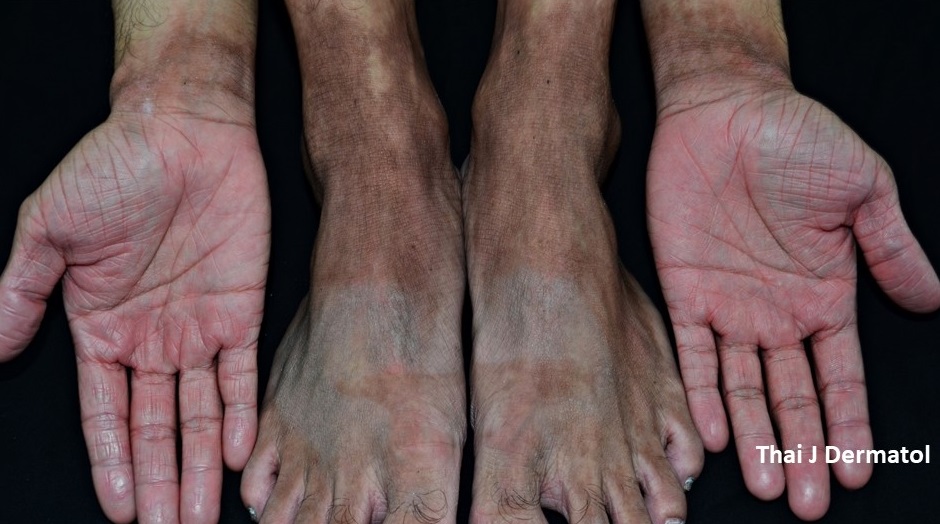Symmetrical Acrokeratoderma: A Case Report in Thailand
Keywords:
Symmetrical acrokeratoderma, pigmented carpotarsal hyperkeratosis, hyperkeratosis nigricans carpi et tarsi, aquagenic responseAbstract
Symmetrical acrokeratoderma is a newly recognized skin disease, mostly affecting young and middle-aged males of Chinese descent. We report the first case of symmetrical acrokeratoderma in Thailand. Our case was a young Thai man presenting with asymptomatic brown to black hyperkeratotic patches distributed symmetrically on the volar side of the wrists, lateral aspect of the hands and dorsum of the fingers, ankles and feet without lesions on the palmoplantar side. After his hands were immersed in water, whitish-grayish maceration was observed. He was treated with a 10% salicylic acid cream, advised to avoid aggravating factors. The lesions persisted with mild improvement in wintertime.
References
Chen W, Song Z, Yang CC, Hao F. Symmetrical acral keratoderma revisited: proposal for a new term, 'pigmented carpotarsal hyperkeratosis'. J Eur Acad Dermatol Venereol 2019;33:277-80.
Vinay K, Sawatkar GU, Saikia UN, Dogra S. Symmetrical acrokeratoderma: a case series in Indian patients. Orphanet J Rare Dis 2016;11:156.
Liu Z, Zhou Y, Chen RY, et al. Symmetrical acrokeratoderma: A peculiar entity in China? Clinicopathologic and immunopathologic study of 34 new cases. J Am Acad Dermatol 2014;70:533-8.
Chen P, Sun S, Zeng K, et al. Exome sequencing identifies a TCF4 mutation in a Chinese pedigree with symmetrical acral keratoderma. J Eur Acad Dermatol Venereol 2018;32:1204-8.
Yang PP, Peng J, Wu YY, et al. Immunohistochemical evaluation of epidermal proliferation, differentiation and melanocytic density in symmetrical acrokeratoderma. Clin Exp Dermatol 2017;42:509-15.
Li CX, Wen J, Zeng K, Tian X, Li XM, Zhang XB. Ultrastructural study of symmetrical acral keratoderma. Ultrastruct Pathol 2014;38:420-4.
Fan YM, Li SF, Yang YP, Chen QX, Li W. Is acquired symmetrical acrokeratoderma a new dermatosis? Two case reports and Chinese literature review. Int J Dermatol 2010;49:647-52.
Rong ML, Zhang ZW, Luo Y, Shi G, Fan YM. Epidermal aquaporin-3 downexpression in symmetrical acrokeratoderma. J Eur Acad Dermatol Venereol 2019;33:e208-e9.
Li CX, Han CL, Zeng K, Zhang XB, Ma ZL. Clinical, demographic and histopathological features of symmetrical acral keratoderma. Br J Dermatol 2014;170:948-51.

Downloads
Published
How to Cite
Issue
Section
License
เนื้อหาและข้อมูลในบทความที่ลงตีพิมพ์ในวารสารโรคผิวหนัง ถือเป็นข้อคิดเห็นและความรับผิดชอบของผู้เขียนบทความโดยตรงซึ่งกองบรรณาธิการวารสาร ไม่จำเป็นต้องเห็นด้วย หรือร่วมรับผิดชอบใดๆ
บทความ ข้อมูล เนื้อหา รูปภาพ ฯลฯ ที่ได้รับการตีพิมพ์ในวารสารโรคผิวหนัง ถือเป็นลิขสิทธิ์ของวารสารฯ หากบุคคลหรือหน่วยงานใดต้องการนำทั้งหมดหรือส่วนหนึ่งส่วนใดไปเผยแพร่ต่อหรือเพื่อกระทำการใดๆ จะต้องได้รับอนุญาตเป็นลายลักอักษรจากบรรณาธิการวารสารโรคผิวหนังก่อนเท่านั้น

